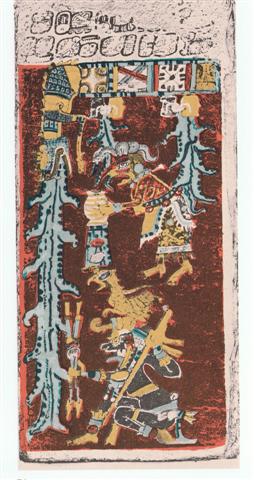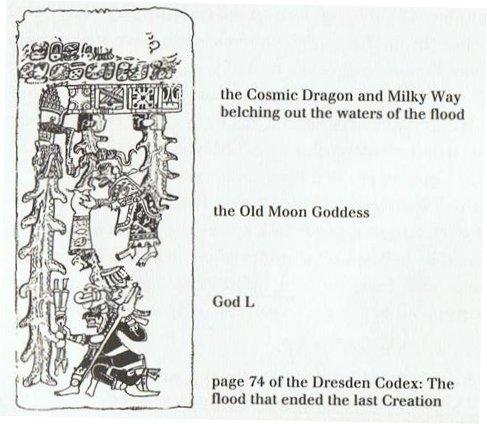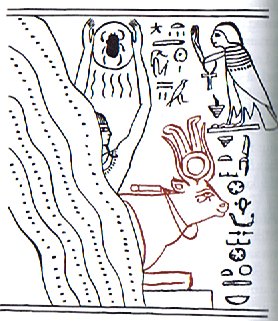1. I think the best way to begin a description of what happens in the 5th right ascension hour is to look at how the Sun beetle is being uplifted above the horizontally drawn Hathor cow:
There is a separation taking place where the 'mountain of winter' is giving way to summer, where land is reappearing again from the inundation, perhaps the receding waters of the Nile, perhaps a similar event observed in the sky roof - or preferably both together.
5 waves of heat are descending from Sun in his beetle form and these will evaporate the water, unveiling the fertile land. From a state of 'embrace', when water is hiding the land, and when there is no firm ground to stand on, sky and earth are breaking apart. In the cycle of the year this corresponds to dawn in the diurnal cycle, when light returns in the east.
This time is the beginning. At the other end of time is the deluge. In the last page of the Mayan Dresden Codex the Flood is illustrated thus:
 
(Comments from Maya Cosmos.)
If the beginning is connected with Hathor (a cow is a creature who needs land to graze on), then several questions arise, foremost of which is when she does emerge and for how long she will be there before land is inundated anew. These are questions relating to cycles (plural) in timespace: "... In the inscriptions of Dendera, published by Dümichen, the goddess Hathor is called 'lady of every joy'. For once, Dümichen adds: Literally ... 'the lady of every heart circuit'. This is not to say that the Egyptians had discovered the circulation of the blood. But the determinative sign for 'heart' often figures as the plumb bob at the end of a plumb line coming from a well-known astronomical or surveying device, the merkhet. Evidently, 'heart' is something very specific, as it were the 'center of gravity' ... See Aeg.Wb. 2, pp. 55f. for sign of the heart (ib) as expressing generally 'the middle, the center'. And this may lead in quite another direction. The Arabs preserved a name for Canopus - besides calling the star Kalb at-tai-man ('heart of the south') ... Suhail el-wezn, 'Canopus Ponderosus', the heavy-weighing Canopus, a name promptly declared meaningless by the experts, but which could well have belonged to an archaic system in which Canopus was the weight at the end of the plumb line, as befitted its important position as a heavy star at the South Pole of the 'waters below'. Here is a chain of inferences which might or might not be valid, but it is allowable to test it, and no inference at all would come from the 'lady of every joy'. The line seems to state that Hathor (= Hat Hor, 'House of Horus') 'rules' the revolution of a specific celestial body - whether or not Canopus is alluded to - or, if we can trust the translation 'every', the revolution of all celestial bodies. As concerns the identity of the ruling lady, the greater possibility speaks for Sirius, but Venus cannot be excluded; in Mexico, too, Venus is called 'heart of the earth'. The reader is invited to imagine for himself what many thousands of such pseudo-primitive or poetic interpretations must lead to: a disfigured interpretation of Egyptian intellectual life ..." (Hamlet's Mill) A heart seems to be depicted inside the head of the rising fish in Gb7-26:
Maybe it refers to Achernar, the star at the beginning of the River, because 72 * 6 = 432. |
|||||||||||||||||||||||||||||||||||||||||||||||||||





